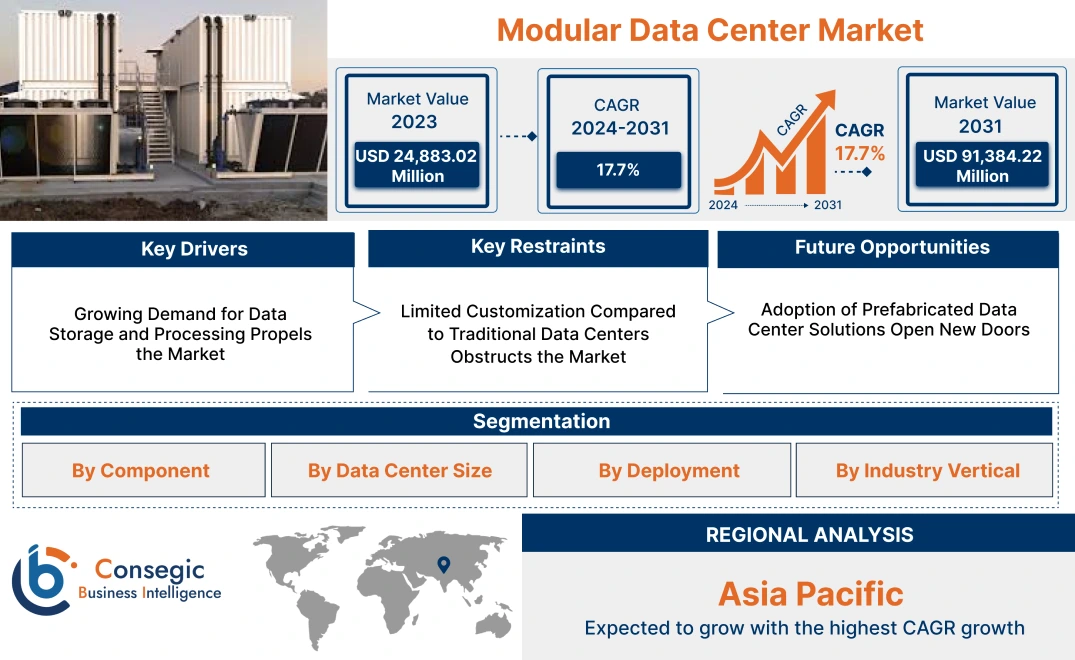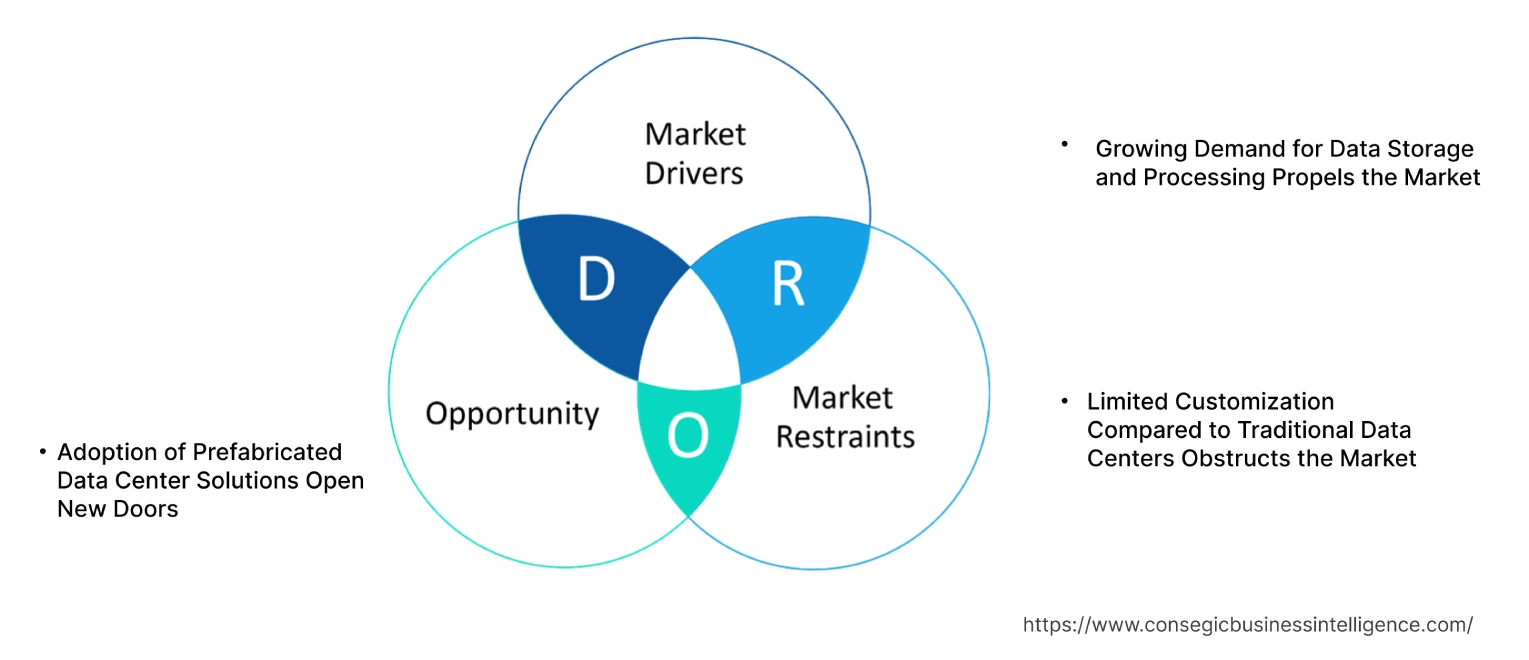Modular Data Center Market Size:
Modular Data Center Market size is estimated to reach over USD 84.31 Billion by 2032 from a value of USD 28.80 Billion in 2024 and is projected to grow by USD 32.71 Billion in 2025, growing at a CAGR of 17.4% from 2025 to 2032.
Modular Data Center Market Scope & Overview:
A modular data center is a prefabricated and portable data center solution comprised of standardized components or modules that can be easily deployed and scaled to meet specific IT infrastructure needs. These modules often contain integrated power, cooling, and networking equipment, offering a flexible and efficient alternative to traditional brick-and-mortar data centers by allowing for rapid deployment, cost-effectiveness, and the ability to expand capacity as required.
How is AI Transforming the Modular Data Center Market?
There is a rising adoption of AI in modular data center market, specifically for enhancing efficiency, reducing costs, and improving security. AI-powered automation and analytics are optimizing resource allocation, predicting failures, and streamlining operations in these data centers.
Moreover, AI integration in modular data centers can assist in automated workflows, managing complex workloads, and adapting to changing demands. Further, AI-powered tools can improve data retrieval, governance, and compliance, in turn ensuring data is managed efficiently and securely. Consequently, the above factors are expected to propel the market growth during the forecast period.
Key Drivers:
Increasing adoption of cloud computing and the rollout of 5G is driving modular data center market growth
Cloud service providers require scalable and flexible infrastructure to accommodate fluctuating user demands and the rapid expansion of cloud services. Modular data centers allow for the incremental deployment of capacity, aligning investments with actual growth and reducing the risk of stranded assets. Additionally, the deployment of 5G networks leads to an increase in data due to higher bandwidth and the proliferation of connected devices. Many 5G applications, such as autonomous vehicles, IoT, and augmented reality, demand ultra-low latency. Modular data centers provide the necessary processing power closer to the network edge, reducing latency, consequently driving the modular data center market size.
- For instance, according to Nokia's Mobile Broadband Index (MBiT) report, India's 5G user numbers are predicted to surge by 2.65 times between 2024 and 2028. The report anticipates the subscriber base will jump from 290 million in 2024 to a substantial 770 million by 2028.
Consequently, increasing adoption of cloud computing and the rollout of 5G is driving modular data center market growth.
Key Restraints :
Limitations in customization are restraining the global modular data center market
The modular nature imposes limitations on the physical layout and the integration of specific, non-standard equipment. Organizations might have existing systems or require particular spatial arrangements that are difficult to achieve with the fixed dimensions and configurations of standard modules. Integrating specialized cooling systems or unique power distribution architectures also present challenges, further hampering the market expansion.
Therefore, as per the analysis, these combined factors are significantly hindering modular data center market share.
Future Opportunities :
Escalating demand for sustainable and energy-efficient solutions is projected to create modular data center market opportunity
Energy consumption is a substantial operational expense for traditional data centers and modular data centers are designed with a strong emphasis on energy efficiency. This includes features like optimized airflow management, advanced cooling technologies (such as free cooling or liquid cooling), and intelligent power management systems. By significantly reducing energy consumption, modular data centers offer lower operational costs over their lifecycle, becoming a financially attractive option for businesses to minimize expenses, hence boosting modular data center market trend.
Hence, based on the analysis, escalating need for sustainable and energy-efficient solutions is expected to create modular data center market opportunities.
Modular Data Center Market Segmental Analysis :
By Component:
Based on the Component, the market is categorized into Solutions and Services.
Modular data center solutions and services offer prefabricated, scalable, and portable infrastructure components for creating or expanding data centers quickly and efficiently. These solutions include pre-configured all-in-one or power reference designs, simplifying project design and speeding up the deployment process. Services related to modular data centers include project management, installation, maintenance, and support, which ensure smooth implementation and long-term operation.
Trends in the Component:
- Rising trend towards the adoption of fully integrated, turnkey modular data center solutions.
- Vendors and third-party providers offer services to help organizations plan, design, and select the right modular solutions based on their specific requirements.
Solutions accounted for the largest revenue share in the market in 2024.
Micro data centers, which are smaller, self-contained units designed for edge computing, are increasingly offered as complete solutions. These integrate compute, storage, networking, power, and cooling in a compact and manageable form factor. Vendors are providing these as pre-configured packages for easy deployment in various environments, from office spaces to retail locations, thereby boosting the modular data center market size.
- For instance, in July 2024, Vertiv released its MegaMod CoolChip, a high-density prefabricated modular data center solution designed to speed up the global deployment of AI computing infrastructure. This turnkey solution integrates top-tier technologies, including advanced liquid cooling, enabling deployment up to 50% faster compared to traditional on-site construction.
Thus, as per the modular data center market analysis, the aforementioned factors are driving solutions segment.
Services are also projected to register the fastest CAGR during the forecast period.
Integration and deployment services including physical installation of the modules, connectivity setup, and integration with existing infrastructure is driving market extension. Additionally, modular facilities require ongoing maintenance and support to ensure optimal performance, reliability, and longevity. Service offerings in this area include preventative maintenance, remote monitoring, technical support, and on-site assistance. Thus, as per the modular data center market analysis, the aforementioned factors are driving the services segment.
By Data Center Size:
Based on the Data Center Size, the market is classified into Small Data Center, Mid-sized Data Center, and Large-sized Data Center.
Modular data centers can be scaled to fit different organization sizes, including small, mid-sized, and large-sized data centers. Small and mid-sized modular data centers are often suitable for startups and smaller businesses, while large modular data centers are used by larger enterprises to meet their extensive IT infrastructure needs.
Trends in the Data Center Size:
- A major trend is the rise of smaller data centers strategically located at the network edge to support low-latency applications for IoT, 5G, and real-time processing.
- Compact, self-contained units are being deployed in various environments like offices and retail spaces for localized computing and data processing.
Large-sized Data Center accounted for the largest market share of 47.85% in 2024.
The demand for massive computing power from cloud providers and large enterprises is driving the growth of hyperscale data centers with unprecedented scale and capacity. Additionally, the rapid adoption of AI and machine learning is leading to significant investments in expanding the capacity of large data centers, with a focus on high-density GPU clusters. Moreover, large data center operators are under increasing pressure to meet ambitious sustainability targets, driving investments in renewable energy sources, energy-efficient designs, and innovative cooling technologies. Thus, as per the modular data center market analysis, the aforementioned factors are driving the large-sized data center segment.
Mid-sized Data Center is projected to register the fastest CAGR during the forecast period.
Many mid-sized organizations are opting for hybrid IT strategies, combining on-premises mid-sized data centers with cloud services for flexibility and cost optimization. Additionally, these data centers are adapting to increasing rack densities driven by technologies like AI, requiring more advanced cooling solutions like liquid cooling and high-density air cooling are also contributing notably in spurring the market growth.
- For instance, Vertiv's SmartMod Max CW is a prefabricated modular data center that can scale up to 200kW, suitable for mid-sized deployments needing rapid capacity.
Thus, as per the modular data center market analysis, the aforementioned factors are driving mid-sized data center segment growth.
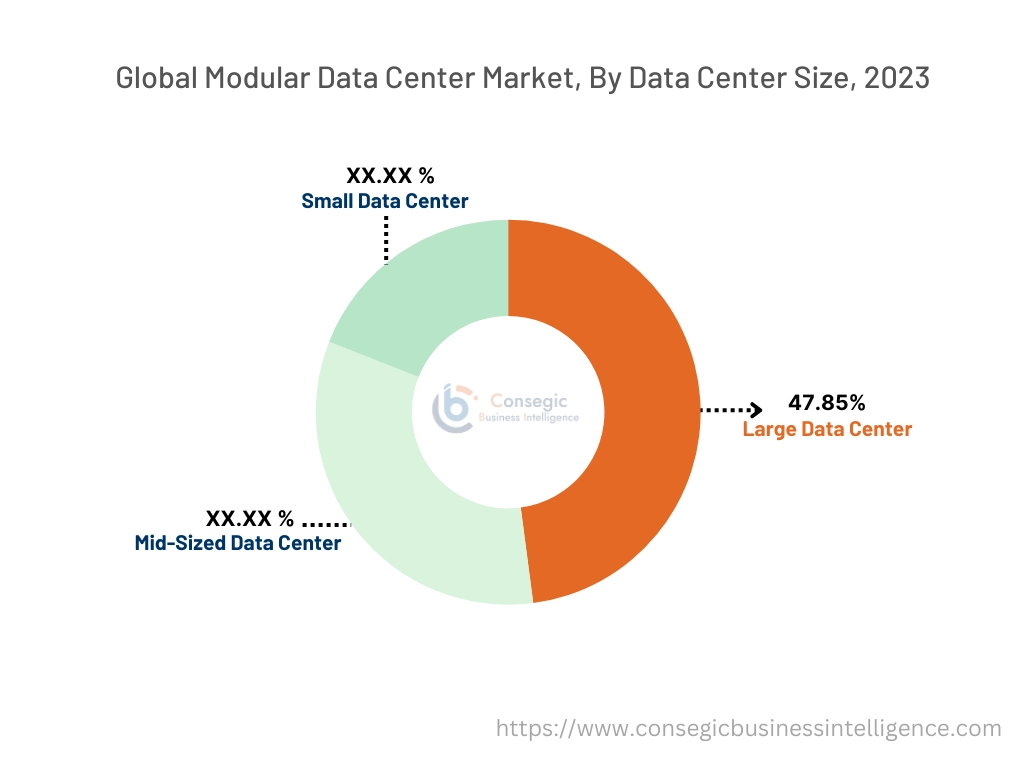
By Industry Vertical:
Based on the Industry Vertical, the market is divided into IT & Telecom, BFSI, Healthcare, Government & Defense, Retail, Energy, and Others.
Modular data centers are rapidly gaining traction across diverse industries like IT & Telecom, BFSI, Healthcare, Government & Defense, Retail, and Energy due to their flexibility, scalability, and rapid deployment capabilities. In IT & telecom sector, these data centers offer the flexibility to handle the demands of cloud computing, virtualization, and high-density servers. In BFSI sector, the robust and scalable infrastructure is crucial for financial institutions, and modular data centers provide this. Moreover, these data centers enable healthcare organizations to deploy infrastructure quickly and in diverse locations, ensuring uninterrupted access to critical systems. For government organizations, these data centers offer a scalable and adaptable solution for various applications, including cloud environments and deployment camps. In energy sector, these data centers can help energy companies manage and analyze large amounts of data, optimizing operations and improving efficiency.
Trends in the Industry Vertical:
- Increasing trend in BFSI ensuring robust protection for sensitive financial data with multi-layered physical and digital security measures and adhering to regulations like GDPR, CCPA, and PSD2.
- Growing trend on data localization, control, and stringent security protocols to protect sensitive government and defense information.
IT & Telecom accounted for the largest revenue in 2024.
The rapid increase of edge computing, fueled by 5G and IoT, necessitates smaller, strategically located data centers for low-latency applications. The increasing demand for AI and machine learning workloads is driving the need for high-density computing environments and specialized hardware within data centers. To handle the massive data generated, decentralized architectures are gaining traction, pushing computers closer to the data source. Consequently, the expanding IT & telecom sector is contributing significantly in propelling the market growth.
- For instance, the Indian Department of Telecommunications and IT received a budget allocation of USD 9.27 billion in the Union Budget 2025-26. The telecom sector in India attracted significant foreign direct investment (FDI) USD 39.99 billion between April 2000 and September 2024. Furthermore, India holds the third position globally in terms of annual investment in telecommunication services and domestic market size.
Thus, the market analysis depicts that the aforementioned factors are boosting the market.
Healthcare is predicted to register the fastest CAGR during the forecast period.
The increasing adoption of digital health technologies, such as electronic health records (EHRs), telehealth platforms, and medical imaging systems, is generating vast amounts of patient data, necessitating secure data storage and processing capabilities. The need for low-latency access to data for critical applications, including real-time diagnostics and remote patient monitoring, is also a significant driver.
- For instance, according to National Library of Medicine, telehealth visits experienced a dramatic 89% jump from 2019 to 2020 (51,589 to 97,461), followed by a further 21% increase in 2021, reaching 117,730 visits. Notably, the vast majority (92.57%) of telehealth patients between 2020 and 2022 were covered by major insurance providers, including Medicare, Blue Cross and Blue Shield, commercial and managed care plans, Medicaid, and Medicare Managed Care.
Subsequently, the above-mentioned factors are contributing notably in spurring modular data center market expansion.
Regional Analysis:
The global modular data center market has been classified by region into North America, Europe, Asia-Pacific, Middle East & Africa, and Latin America.
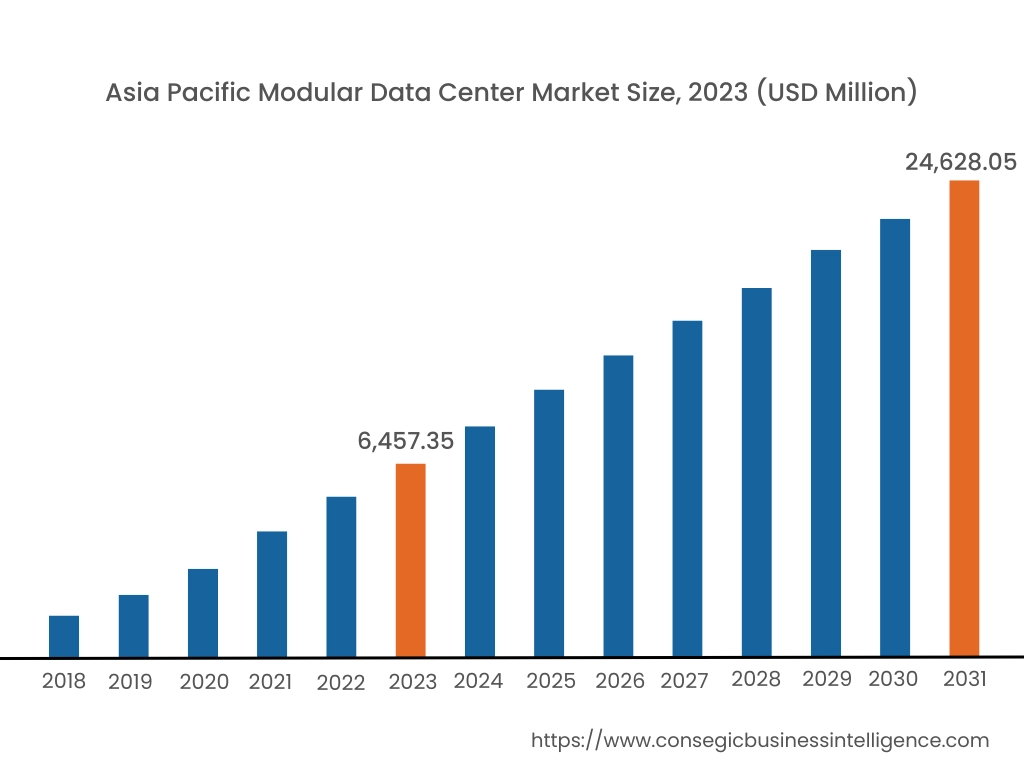
In 2024, Asia Pacific was valued at USD 7.78 Billion and is expected to reach USD 27.1 Billion in 2032. In Asia Pacific, China accounted for the highest share of 33.9% during the base year of 2024. The increase is fueled by a confluence of factors, including rapid demographic shifts with an aging population, rising affluence leading to higher healthcare spending, and significant investments in healthcare infrastructure and technology. The prevalence of chronic diseases like diabetes and cancer in the region is also driving demand for advanced healthcare services and innovative treatment models.
- For instance, the Indian telemedicine market is poised for significant increase, projected to reach USD 5.5 billion by the end of 2025. This growth underscores a necessary evolution within the Indian healthcare system, advocating for a shift away from conventional in-person doctor-patient visits towards digitally enabled remote consultations.
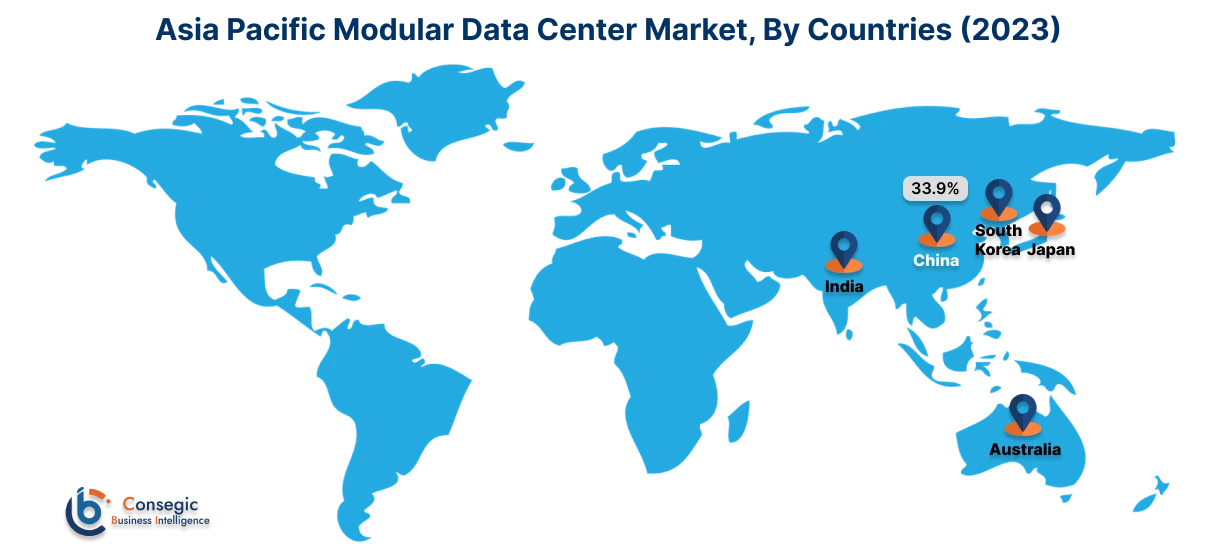
North America region was valued at USD 9.98 Billion in 2024. Moreover, it is projected to grow by USD 11.42 Billion in 2025 and reach over USD 32.23 Billion by 2032. The rapid adoption of advanced technologies like IoT, AI, and big data necessitates robust data processing and storage capabilities, which modular data centers can efficiently provide. Furthermore, the increasing focus on edge computing to reduce latency and improve real-time decision-making is boosting the demand for modular solutions that can be deployed closer to the data source.
As per the modular data center market analysis, stringent energy efficiency regulations and carbon emission targets set by the European Union are accelerating the adoption of energy-efficient modular solutions.
Latin America market is fueled by increasing digitalization across various sectors, including BFSI, IT & Telecom, and healthcare, coupled with the development of robust fiber connectivity and a more reliable power supply. Moreover, in the Middle East and Africa market is driven by rapid digital transformation initiatives, increasing adoption of cloud computing and digital services, and favorable government policies supporting the development of data center infrastructure.
Top Key Players & Market Share Insights:
The market is highly competitive with major players providing modular data center to the national and international markets. Key players are adopting several strategies in research and development (R&D), product innovation, and end-user launches to hold a strong position in the market. Key players in the modular data center industry include-
- Schneider Electric (France)
- Eaton Corporation (Ireland)
- Rittal GmbH & Co. KG (Germany)
- Delta Electronics (Taiwan)
- Johnson Controls International (United States)
- Hubbell (PCX) (United States)
- Vertiv Group (United States)
- Huawei Technologies (China)
- Dell Technologies (United States)
- Hewlett Packard Enterprise (HPE) (United States)
- IBM Corporation (United States)
- ABB Ltd (Switzerland)
Recent Industry Developments :
Collaboration:
- In Nov 2024, Untether AI and Vertical Data partnered to develop advanced modular and portable data center solutions. This collaboration aims to integrate Untether AI's high-performance AI inference accelerators with Vertical Data's infrastructure, enabling faster, more secure, and more efficient AI-driven computing at the source of data generation, benefiting applications like smart cities and edge computing.
Modular Data Center Market Report Insights :
| Report Attributes | Report Details |
| Study Timeline | 2018-2031 |
| Market Size in 2031 | USD 84.31 Billion |
| CAGR (2024-2031) | 17.4% |
| By Component |
|
| By Data Center Size |
|
| By Deployment |
|
| By Industry Vertical |
|
| By Region |
|
| Key Players |
|
| North America | U.S. Canada Mexico |
| Europe | U.K. Germany France Spain Italy Russia Benelux Rest of Europe |
| APAC | China South Korea Japan India Australia ASEAN Rest of Asia-Pacific |
| Middle East and Africa | GCC Turkey South Africa Rest of MEA |
| LATAM | Brazil Argentina Chile Rest of LATAM |
| Report Coverage |
|
Key Questions Answered in the Report
How big is the modular data center market? +
The modular data center market size is estimated to reach over USD 84.31 Billion by 2032 from a value of USD 28.80 Billion in 2024 and is projected to grow by USD 32.71 Billion in 2025, growing at a CAGR of 17.4% from 2025 to 2032.
What specific segmentation details are covered in the modular data center report? +
The modular data center report includes specific segmentation details for component, data center size, industry vertical, and regions.
Which is the fastest segment anticipated to impact the market growth? +
In the modular data center market, healthcare is the fastest growing segment during the forecast period.
Who are the major players in the modular data center market? +
The key participants in the modular data center market are Schneider Electric (France), Eaton Corporation (Ireland), Vertiv Group (United States), Huawei Technologies (China), Dell Technologies (United States), Hewlett Packard Enterprise (HPE) (United States), IBM Corporation (United States), ABB Ltd (Switzerland), Rittal GmbH & Co. KG (Germany), Delta Electronics (Taiwan), Johnson Controls International (United States), Hubbell (PCX) (United States), and Others.
